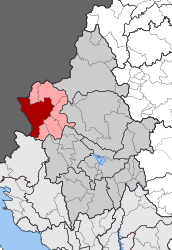Delvinaki
Delvinaki (Greek: Δελβινάκι) is a former municipality in the Ioannina regional unit, Epirus, Greece. Since the 2011 local government reform it is part of the municipality Pogoni, of which it is a municipal unit.[2] The municipal unit has an area of 255.835 km2, the community 54.824 km2.[3] In 2011 its population was 772 for the village and 2,540 for the municipal unit. Delvinaki is part of the traditional area Pogoni.
Delvinaki Δελβινάκι | |
|---|---|
 Delvinaki Location within the regional unit  | |
| Coordinates: 39°56′N 20°28′E | |
| Country | Greece |
| Administrative region | Epirus |
| Regional unit | Ioannina |
| Municipality | Pogoni |
| Districts | 17 |
| • Municipal unit | 255.835 km2 (98.778 sq mi) |
| Population (2011)[1] | |
| • Municipal unit | 2,540 |
| • Municipal unit density | 9.9/km2 (26/sq mi) |
| Community | |
| • Population | 772 (2011) |
| • Area (km2) | 54.824 |
| Time zone | UTC+2 (EET) |
| • Summer (DST) | UTC+3 (EEST) |
| Postal code | 440 04 |
| Vehicle registration | IN |
Delvinaki is situated on the road GR-22/E853 which links Kalpaki with the Albanian border. The border crossing Kakavia is west of town.
Subdivisions
The municipal unit Delvinaki is subdivided into the following communities (constituent villages in brackets):
Population
| Year | Village population | Municipal unit population |
|---|---|---|
| 1981 | 884 | - |
| 1991 | 922 | - |
| 2001 | 751 | 2,933 |
| 2011 | 772 | 2,540 |
History
From the 14th century and to beginning of Ottoman rule Delvinaki was among the thriving settlements of the region together with nearby Dipalitsa, Kastaniani and Polytsiani.[5] During the first decades of the 14th century, Albanians settled in the Pogoni region and their presence is evidenced through some place names derived from the Albanian language such as Delvinaki (place of vineyards) and Gouveri (from gouva = hollow).[6][7] The town was an important commercial centre during the Ottoman period.[8] The church of the Dormition of the Theotokos in Delvinaki was erected in 1619.[9] In the late 17th century, Ottoman traveler Evliya Çelebi passed through Delvinaki observing that it was "prosperous" and in Pogoni, "inhabited by infidels all Albanians" containing 400 houses, 6000 fertile vineyards, 40-50 shops, 10 churches and 3 inns.[10] Çelebi also noted that Delvinaki was a hass (revenue estate) of an Ottoman admiral and administered by a voivode with the settlement being "exempt from taxation and state interference."[10] Those Albanian villagers who settled in the southern part of Pogoni were gradually assimilated by the Greek element.[6] British traveler John Hobhouse noted in early 19th century that Delvinaki consisted of 300 dwellings inhabited by Greeks.[11]
Delvinaki joined Greece after the Balkan Wars of 1913.
Culture
Delvinaki is home to Greek polyphonic singing and has a reach music tradition in the wider Pogoni region. It is one of the two main centres of folk music of Pogoni, the other being Parakalamos.[8] An annual festival of polyphonic singing is held in August.[9]
Notable people
- Petroloukas Chalkias, musician.
- Hatzimichalis Dalianis, hero of the Greek War of Independence.
- Evangelos Psimmas, (1905–1962), bishop of Ermoupoli.
- Konstantinos Iroklis Vasiadis, (1821–1890), scholar.
References
- "Απογραφή Πληθυσμού - Κατοικιών 2011. ΜΟΝΙΜΟΣ Πληθυσμός" (in Greek). Hellenic Statistical Authority.
- Kallikratis law Greece Ministry of Interior (in Greek)
- "Population & housing census 2001 (incl. area and average elevation)" (PDF) (in Greek). National Statistical Service of Greece. Archived from the original (PDF) on 2015-09-21.
- "Πανδέκτης: Gkouvéri -- Farángion". Retrieved 2019-10-03. Pandektis: Name Changes of Settlements in Greece, compiled by the Institute for Neohellenic Research
- Vakolopoulos, 2003, p. "Ορισμένα χωριά της Πωγωνιανής γνώρισαν κατά το 14ο κυρίως αιώνα και στις αρχές της Τουρκοκρατίας μεγάλη οικονομική ανάπτυξη. Τότε συγκροτούσαν αξιόλογες κωμοπόλεις και πόλεις με ιδιαίτερη εμπορική σημασία. Εκτός από την περίφημη εμποροπανήγυρη της Διπαλίτσας πραγματοποιούνταν κάθε εβδομάδα εμποροπανηγύρεις και στα γύρω αστικά κέντρα: στην Πολίτσιανη, στην Καστάνιανη και στο Δελβινάκι."
- Vakalopoulos, Kōnstantinos Apostolou (2003). Historia tēs Ēpeirou: apo tis arches tēs Othōmanokratias hōs tis meres mas. Hērodotos. p. 322. ISBN 9607290976.CS1 maint: ref=harv (link)"Κατά τις πρώτες δεκαετίες του 14ου αιώνα τοποθετείται χρονικά η αλβανική διείσδυση στο χώρο της Πωγωνιανής, που μαρτυρείται και από ορισμένα τοπωνύμια όπως το Δελβινάκι (αμπελότοπος), το Γκουβέρι (γκούβα = κοίλωμα), αλλά και από τις μετακινήσείς αλβανικόν οικογενειών, οι οποίες εξισλαμήστικαν λόγω των σινθηκών που επικρατούσαν. Όσοι αλβανικοί πλιθυσμοί είηαν εγκατασταθεί στο νότιο τμήμα του Πωγωνίου, αφομοιώθηκαν βαθμιαία από το ελληνικό στοιχείο και εξελληνίστικαν. Όλες οι κοινότητες...."
- Ifantis, Nikos Th. (2005). Η Πωγωνιανή - Παλιά Βοστίνα και τα Κοινοτικά Διαμερίσματα Δολό-Δρυμάδες-Σταυροσκιάδι. Διευρυμένη Κοινότητα Πωγωνιανής. p. 45.CS1 maint: ref=harv (link) "όπως και από αλβανικές ονομασίες χωριών: Ρομπάτες (= ρόμπα, ένδυμα), Δελβινακίων (= αμπελότοπος), Γούβερη (Γούβα - Κοίλωμα) κ.λ.π."
- Μουσική από την Ήπειρο. Institution of the Hellenic Parliament. p. 47. ISBN 978-960-6757-07-5.
- "Prefecture of Ioannina, Epirus-Greece" (PDF). Prefectural Committee of Tourist Promotion. 2008. p. 29. Retrieved 2009-11-02.
- Dankoff, Robert; Elsie, Robert (2000). Evliya Çelebi in Albania and Adjacent Regions: Kossovo, Montenegro, Ohrid. Brill. p. 91. ISBN 9789004116245.CS1 maint: ref=harv (link) "We returned by another road, passing through prosperous villages. After 4 hours of travelling westwards, we arrived at Delvinaki. It is a prosperous town on the border of the district of Pogonia and consists of 400 houses inhabited by infidels all Albanians and 6000 fertile vineyards. It has 40 to 50 shops, 10 churches and 3 hans. This town is a has belonging to the admiral of the Ottoman fleet and administered by a voyvoda. It is exempt from taxation and state interference."
- Vakolopoulos, 2003, p. 323: "Ο Hobhouse αναφέρει ότι στο Δελβινάκι υπήρχαν 300 ελληνικά σπίτια"